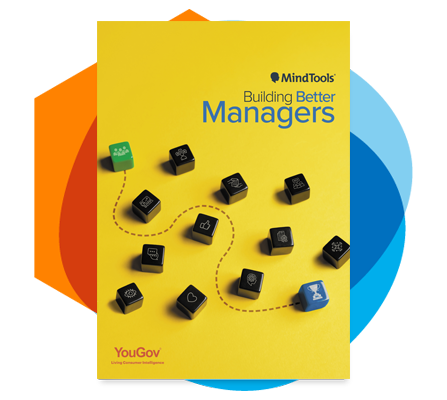
*This resource by MindTools is recommended for its educational value and is not an EDU Fellowship original work. All rights belong to the original creators.
It’s clear that managers' roles are evolving fast, and Mind Tools' "Building Better Managers" report dives into the shift from traditional management focused on control and efficiency to a more people-centered, empathy-driven approach. This report advocates that a manager's ability to support, coach, and inspire their teams directly influences business outcomes like engagement, retention, and innovation.
The big idea? A good manager in 2024 is more than technical skills or setting goals. It's about emotional intelligence, building trust, and being a coach who actively listens and fosters growth. This resource introduces practical strategies that L&D professionals can use to support managers, focusing on four core areas: empathy, setting clear expectations, motivating teams, and developing people.
For L&D pros, this shift means thinking beyond traditional training programs. We’re now tasked with creating environments where learning is ongoing, managers are supported, and soft skills are valued as hard ones. If your organization is grappling with manager development or you’re looking for ways to enhance leadership training, this resource is packed with insights tailored to the modern manager’s journey.
Want to rethink how you support your managers? This is the perfect starting point to explore the new expectations and the tools you need to build better leaders.
💭 Parable: The Mountain Climb
Once, there was a village at the foot of a towering mountain. Each year, they chose leaders to guide them to the summit, believing the journey would bring success and wisdom. But the climb was tough, and many failed because their leaders weren’t prepared for the challenges.
This time, the village chose a new group of leaders. Some had climbed before, others had not. Those who succeeded didn’t bark orders from the front; instead, they walked alongside their teams, offering support and guidance. They listened, adapted when obstacles arose, and motivated everyone to keep going.
One leader, without proper training, struggled when the climb became difficult. His team was confused and lost. In contrast, another leader, who had been coached and supported beforehand, knew exactly when to push and when to pause. She tapped into each person's strengths and led her team to the summit.
The lesson? Leaders need the right tools, emotional intelligence, and support to guide their teams to success. Without it, even the most determined teams can fall short of their goals.
🥡 My Key Takeaways for Building Better Leaders in 2024
Empathy is the heart of good management
Empathetic managers boost engagement, foster innovation, and keep employees around longer. When managers show real care for their teams, it builds trust, creates psychological safety, and leads to a more inclusive culture. It’s more than just listening—empathy helps managers connect on a human level, making people feel valued and supported.
How to build empathy in management:
- Offer emotional intelligence and active listening workshops to leadership programs. Role-playing tough conversations can help managers practice empathy.
- Implement regular 360-degree feedback sessions so managers can get input on their empathy and leadership style.
- Senior leaders should regularly show empathy in meetings and communications, setting an example for emotional intelligence.
Goal setting should be clear, not complicated
Many managers struggle with setting clear, actionable goals. The key is not making goals too ambitious but understandable and attainable. Good managers break down company objectives into realistic steps their teams can follow, improving engagement and performance.
How to set clear goals:
- Teach managers to set SMART (Specific, Measurable, Achievable, Relevant, Time-bound) goals that align with business outcomes and individual growth.
- Encourage managers to involve their teams in creating goals. This fosters accountability and makes goals more achievable.
- Create a system for revisiting and adjusting goals based on team feedback and changing priorities.
Coaching is the new leadership standard
Today’s managers need to be coaches, not just taskmasters. They should guide and mentor employees, helping them grow. This doesn’t mean having all the answers, but knowing how to ask the right questions and offer the right resources. Coaching also promotes a culture of learning and growth.
How to promote a coaching culture:
- Provide coaching technique training, focusing on listening, questioning, and offering constructive feedback.
- Create networks where managers can learn from each other’s coaching experiences.
- Encourage regular one-on-one check-ins focused on professional growth and removing barriers to success.
Learning-focused managers fuel growth
Managers who prioritize learning drive employee engagement and performance. However, many don’t share learning opportunities or recognize their teams' strengths and interests.
How to support learning-focused leadership:
- Give managers easy access to learning content they can share with their teams. Align these resources with team and business goals.
- Set up rewards for managers who actively support their team’s learning, like incentives for promoting courses or learning challenges.
- Encourage managers to include learning in regular team conversations so that it becomes a natural part of the culture.
Empathy and learning help retain employees
Keeping employees isn’t just about pay and perks. Managers who care about their team’s emotional well-being and professional development create environments where people want to stay. The report shows that lack of empathy and learning opportunities are big reasons employees leave.
How to improve retention with empathy and development:
- Include emotional and professional support in your retention plans. Regularly check in on team satisfaction and learning needs.
- Help managers work with employees to create clear development paths, offering growth that keeps them motivated to stay.
- Set up mentorship or buddy programs that pair employees with empathetic leaders. This human connection makes a big difference.
Supported managers lead better
Managers who feel supported by their organization perform better overall, whether coaching, setting goals, or leading teams. Support must start early in a manager’s journey to build confidence, but many companies still don’t provide enough of it.
How to provide better manager support:
- Offer a deep onboarding process for new managers, focusing on leadership, coaching, and communication skills.
- Set up regular touchpoints for managers to access resources, advice, or mentors.
- Survey managers regularly on how well-supported they feel and adjust development programs based on their feedback.
Building better managers FAQs
Q: How can I encourage empathy among managers who are resistant to emotional intelligence training?
A: Empathy can be developed, but it’s often a skill managers don’t think they need. Start by integrating empathy into existing leadership development programs in practical ways. Workshops focusing on active listening and role-playing difficult conversations can make empathy feel more relevant to their daily roles. Highlight the impact of empathetic leadership on team performance, trust, and retention, making it clear that empathy isn’t optional—it directly affects outcomes like engagement and innovation.
Q: What if managers are too busy to engage in coaching or goal-setting practices?
A: Time constraints are a common challenge. The key is to integrate coaching and goal-setting into existing processes. Encourage managers to incorporate one-on-one check-ins as part of their weekly or bi-weekly routine. These don’t need to be long but should be focused on development and support. For goal setting, use team meetings to collectively break down company objectives into actionable steps.
Q: How can I measure the impact of empathy training and leadership coaching?
A: Start by using 360-degree feedback, which allows team members to share how they perceive their manager’s empathy and coaching effectiveness. Additionally, track engagement scores and employee turnover before and after training programs. Look for changes in team collaboration, innovation, and employee satisfaction surveys as indicators of improvement.
Q: My organization is struggling to retain managers under 35—how can we better support them?
A: Younger managers are particularly driven by learning opportunities. Make sure they have clear development pathways and access to mentorship programs. Regularly discuss their growth plans, and show them how their leadership roles contribute to both their career progression and the organization’s success. Offering targeted leadership training and more autonomy in their roles can also improve retention.
Q: How can I convince senior leadership to invest more in management training?
A: Present data that links strong management capabilities—like empathy, goal setting, and coaching—with business outcomes. Highlight how better-supported managers improve team productivity, innovation, and retention. You can also draw attention to the cost of poor management, which often leads to higher employee turnover, stress, and disengagement. Show them the ROI through metrics like employee engagement scores and turnover rates.
Q: What if our managers don’t know what “good management” looks like?
A: Many managers struggle with this. Provide clear examples of what good management entails by setting expectations around key skills like empathy, coaching, goal setting, and inclusivity. Offer them real-life scenarios and case studies to illustrate these practices. You can also create frameworks or checklists that outline specific behaviors and outcomes they should aim for.
🌎 Case Study: How empathy and coaching transformed Sarah’s team
How Empathy and Coaching Transformed Sarah’s Team
Sarah, a newly promoted manager at a mid-sized tech startup, quickly realized that leading a team was more complicated than expected. Her team of eight software developers was missing deadlines, seemed disengaged, and often confused about priorities. Some team members, like John, a senior developer, were becoming increasingly unmotivated, which worried Sarah.
Her first attempts at solving the issues didn’t work. She gave more detailed instructions, leading to micromanaging and further tension. Realizing this approach was ineffective, Sarah enrolled in her company's leadership program, focusing on empathy, goal-setting, and coaching.
Step 1: Empathy Through Active Listening
During one of the workshops, Sarah learned the importance of empathy and active listening. She realized she wasn’t fully understanding her team’s needs and that her communication style left little room for them to share their challenges. So, she scheduled one-on-one meetings with each team member, clarifying that the focus was to understand their perspectives rather than discuss performance.
In her meeting with John, he finally opened up. He explained that the constant shifts in priorities made it impossible for him to do his job well. He often received conflicting directions from Sarah and other team leads, which was confusing and frustrating. He also mentioned that his contributions were overlooked, making him less invested in his work.
Sarah didn’t jump in with solutions; instead, she listened and empathized. She acknowledged how difficult it must have been to manage conflicting demands and reassured John that his concerns were valid.
Step 2: Setting Clear, Attainable Goals
After these discussions, Sarah realized that unclear expectations were a big part of the problem. The company’s objectives were often vague and ambitious, leaving her team unsure of what they were supposed to focus on. With the goal-setting training she received, Sarah decided to make changes.
During their next team meeting, Sarah introduced the SMART goal-setting framework: Specific, Measurable, Achievable, Relevant, and Time-bound. Instead of giving the team general goals like "improve user experience" over the next quarter, she worked with them to break down the objective into specific steps, such as "redesign the navigation menu based on user feedback" within two weeks. Each team member was assigned clear tasks and collectively agreed on deadlines.
By breaking goals into smaller, more manageable pieces, Sarah helped everyone understand their roles. The team left the meeting with a sense of clarity, knowing exactly what was expected.
Step 3: Coaching, Not Directing
One key lesson from the leadership program was that modern managers should focus on coaching rather than simply giving orders. Sarah decided to shift her approach during her one-on-one meetings. Instead of asking for status updates, she focused on helping her team solve their own problems.
For example, when John was stuck on a coding challenge, Sarah didn’t immediately give him a solution. Instead, she asked, “What approaches have you already tried?” and “What do you think could work next?” This questioning method encouraged John to think critically and develop solutions, helping him build confidence.
Sarah also discussed her team members’ professional goals during these check-ins. She encouraged them to think about the skills they wanted to develop, which helped foster a sense of growth within the team.
Step 4: Fostering a Culture of Continuous Learning
Sarah knew keeping her team engaged would require more than solving immediate project issues. She wanted to create an environment where learning and development were a priority. To do this, she started sharing relevant learning resources during team meetings, such as online courses and industry articles. Each member was encouraged to pick at least one learning opportunity aligned with their interests and the team’s needs.
For example, John expressed interest in learning more about cloud computing. Sarah helped him find a short course and allowed him time during the workweek to focus on it. This helped John develop his skills and gave him a renewed sense of purpose.
In team meetings, Sarah encouraged everyone to share something new they had learned that could benefit the team. This initiative sparked discussions and created a sense of shared growth, making learning a part of their culture.
Note: This case study is a hypothetical example created for illustrative purposes only.
💡Other creative approaches to strengthen leadership and team management
- 📝 'Monday Empathy Check-In': Kick off the week with a brief, structured check-in where managers ask team members about any challenges they might face. This simple ritual fosters empathy and creates a culture where employees feel cared for, enhancing psychological safety and trust across the team.
- 🌟 'Quarterly Goal Reflection': Every quarter, hold a 'Goal Reflection' meeting where the team looks back at the goals they set, evaluates progress, and adjusts for the next quarter. This promotes a culture of accountability and ensures that goals remain relevant, motivating, and achievable.
- 📣 'Wins and Learning Moments': In team meetings, dedicate time to highlight personal and collective wins and key learning moments. This keeps the focus on both achievements and growth, encouraging continuous improvement while celebrating success.
- 🔄 'Growth Conversation One-on-Ones': Set up bi-weekly one-on-one meetings focused on professional development. Instead of just tracking tasks, managers should coach team members through challenges and discuss career aspirations. This ritual fosters a culture of coaching rather than commanding.
- 🔵 'Empathy Circle' for Managers: Once a month, managers participate in an 'Empathy Circle' where they share their struggles and successes with peers. This supports emotional intelligence development and encourages managers to learn from each other’s experiences, reinforcing the importance of empathy in leadership.
- 📚 'Peer Coaching Friday': Once a month, pair team members for peer coaching sessions where they offer each other feedback and suggestions on current challenges. This promotes shared learning, builds trust, and encourages team collaboration across different levels.
- 🔍 'Feedback Roundtables': At the end of major projects, gather the team for a 'Feedback Roundtable' where everyone shares thoughts on what went well and what could improve. This ritual encourages openness and ensures that both successes and areas for development are addressed promptly.
- 🎯 'Monthly Vision Alignment': At the start of each month, gather the team to revisit and align on the company’s vision and how their goals tie into the broader mission. This ritual keeps everyone focused on the big picture and connected to their purpose in the organization.
- 🎉 'Achievement Spotlight': At the end of each week, spotlight one team member who went above and beyond. Whether they solved a difficult problem or showed leadership, this recognition fosters a positive culture and boosts morale.
- ☕ 'Virtual Coffee Mentorship': Organize monthly virtual coffee chats between senior and newer managers for informal mentorship. This provides newer managers with support and guidance while building relationships across different levels of leadership.
- 🎯 'Weekly Goal Reboot': Hold a quick 'Goal Reboot' session at the end of each week, where each team member reviews progress on their goals and makes adjustments for the coming week. This keeps goals fresh and ensures that everyone stays on track.
- 🎨 'Innovation Power Hour': Dedicate one hour monthly to an 'Innovation Power Hour', during which the team brainstorms new ideas for improving processes or products. This promotes a creativity and continuous improvement culture, allowing everyone to contribute innovative ideas.
- 🎓 'Learning Champions Session': Hold a monthly 'Learning Champions' meeting where managers discuss new learning opportunities, resources, and professional development paths they can share with their teams. This ritual keeps learning at the forefront and empowers managers to be advocates for their teams’ growth.
- 🔍 'Empathy Mapping Session': Host an 'Empathy Mapping' session quarterly. In this session, managers put themselves in their employees’ shoes to understand their motivations, challenges, and needs. This helps them develop more personalized support and effective leadership strategies.
📚 Further Reading








